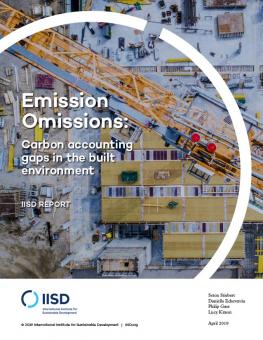
Emission Omissions: Carbon accounting gaps in the built environment
Life-cycle assessment (LCA) studies are the best tool we have to measure the carbon footprints of building products at each phase of their lifespan, but they have some flaws.
Life-cycle assessment (LCA) studies are the main tool used to measure the carbon footprints of building products at each phase of their cradle-to-grave lifespan (i.e., production, use and end of life).
With over 30 per cent of greenhouse gasses (GHGs) in Canada coming from the communities and structures we build for ourselves, accurately measuring building materials' carbon footprints is key to crafting meaningful policy—from building codes to product preference—to meet carbon reduction targets. There is a clear need for us to get this right.
While LCAs are the best-available tool for evaluating the GHG (and other) performance of alternative building products and designs, policy-makers and building designers should be aware there are also limitations, challenges and uncertainties that must be considered.
Media Release: Tool for tracking GHGs in Canada’s buildings has “built in” errors: study
Emission Omissions: Carbon Accounting Gaps in the Built Environment delves into those uncertainties. The report considers:
- Limitations, challenges and uncertainties in existing LCAs, quantifying their significance to the current understanding of the relative GHG performance of buildings made alternatively of concrete, steel or wood structural elements.
- Best practices that could improve the reliability and usefulness of LCA to support effective policies to decarbonize the built environment.
- Longer-term opportunities to reduce life-cycle emissions in the built environment by supporting decarbonization efforts in the concrete, steel and forestry sectors.
The report includes three key recommendations to policy-makers looking to reduce carbon in the building sector:
- Building efficiency and longevity should be the priority for decarbonizing the built environment.
- LCA is the right approach, but more data, transparency and robust standards are needed, especially with respect to biogenic carbon.
- To address embodied GHG emissions in buildings, policy-makers and building professionals need to focus equally on material efficiency and incenting decarbonization across all material manufacturing sectors.
The report was guided and peer reviewed by a diverse Advisory Committee of:
- Keith Brooks, Environmental Defence
- Trevor Hesselink, CPAWS
- Dr. Jay Malcolm, Faculty of Forestry, University of Toronto
- Jamie Meil, Athena Sustainable Materials Institute
- Jean-François Ménard, International Reference Centre for the Life Cycle of Products
- Heidi Nesbitt, Local Practice Architecture + Design
- Dr. Jeff Wells, Boreal Song Bird Initiative
- Scott Demark, BuildGreen Solutions
Participating experts
You might also be interested in
How Fossil Fuels Drive Inflation and Make Life Less Affordable for Canadians
New report takes closer look at how Canada’s dependence on fossil fuels impacts energy costs and prices of essentials such as transportation, home heating, and housing.
How Can We Work With Nature to Tackle Drought and Desertification?
Drought is one of the most devastating and pervasive challenges exacerbated by climate change. However, we can work to reduce its effects through nature-based solutions for land restoration and climate-smart agriculture.
Why Liquefied Natural Gas Expansion in Canada Is Not Worth the Risk
An analysis of the economic and environmental risks of liquified natural gas expansion in Canada.
New Report Highlights Economic and Environmental Costs of Canada’s LNG Expansion
New report explains how LNG expansion will not only hamper Canada’s progress toward its climate goals but also create challenges for the economy in the long term.